Asus TUF Dash F15 review (FX517ZM model – Core i7-12650H, RTX 3060)
This article is my detailed review of the Asus TUF Dash F15 2022 generation, a portable and excellently priced RTX 3060 laptop meant for all-purpose daily use and gaming/school work.
Last year Asus launched a controversial TUF Dash series of all-purpose laptops, 15-inch computers with a slimmer and lighter construction than the average mid-range option out there, as well as balanced mid-range specs and a competitive price tag.
However, at that time Asus chose to implement the Tiger Lake H35 hardware in those laptops, with options for 4C processors only, and that proved to be a very tough sell in an era where most competing platforms offer 6 or 8 Core hardware and superior processing capabilities. This has changed, though, to some extent, with the 2022 Dash F15 generation.
This time around, the 2022 Asus TUF Dash F15 FX517 series is built on Alder Lake 12th gen hardware, with options for up to a Core i7-12650H processor. This is a hybrid design with 6 High-Performance Cores and 4 extra Efficiency cores, as well as various IPC improvements and optimizations compared to the Tiger Lake H35 hardware of the past. Furthermore, Asus brought support for DDR5 memory for this series, implemented a higher power GPU now able to run at up to 105W, implemented a MUX, slightly updated the thermal module to cope with the bump in hardware power, and refreshed the looks and ergonomics to a small degree.
Knowing these, in this article I’m going to tell you what to expect from the 2022 Dash F15 series and how it compares to the thicker and heavier mainstream TUF Gaming models, which still offer faster CPU and GPU capabilities and are only marginally more expensive.
In just a few words, with the Dash F15s, you’re still trading off performance for the portable format and a lower price, but in the past, the deal was hardly justifiable, while with this generation, it can be in some situations.
Specs sheet as reviewed – 2022 ASUS TUF Dash F15
2022 ASUS TUF Dash F15 FX517ZM
Display
15.6-inch, 16:9, non-touch, matte,
FHD 1920 x 1080 px IPS, 300 Hz with 100% sRGB
Processor
Intel Alder Lake Core i7-12650H, 6C+4c/16T
Video
Intel UHD + Nvidia GeForce RTX 3060 Laptop 6GB (up to 100W with Dynamic Boost)
with MUX and Adaptive Sync (no GSync on internal display)
Memory
16 GB DDR5-4800 RAM – up to 64 GB (2x DIMMs)
Storage
1 TB SSD (Samsung PM991A) – 2x M.2 PCIe gen4 slots
Connectivity
WiFi 6 (Intel AX201) 2×2 with Bluetooth 5.2, Gigabit LAN (Intel I219-LM)
Ports
2x USB-A 3.2 gen1, 1x USB-C gen2 with Thunderbolt 4, 1x USB-C gen2 with video, data and charging, HDMI 2.0b, LAN, headphone&mic, Lock
Battery
76Wh, 200 W power adapter, USB-C charging up to 100W
Size
354 mm or 13.93” (w) x 251 mm or 10.19 (d) x 20.7 mm or .81” (h)
Weight
1.95 kg (4.3 lbs), .6 kg (1.32 lbs) power brick and cables, EU version
Extras
rubber-dome white backlit keyboard with NumPad, dual speakers, HD webcam
We might follow up with reviews on other GPU configurations if there’s enough interest.
Design and construction
The TUF Dash series is a thinner, lighter, and somewhat more refined-looking variant of the regular TUF Gaming notebooks.
Our unit is the black color option, with a matte black interior and lid, and a dark gray underside. There’s also another version, with a white lid and bottom, and the same black interior – this one is rather weird to me, as in the past Asus went with an all-white scheme for the previous-gen Dash F15. I haven’t seen it live, but from the available pictures, I preffer this black variant that I have here.
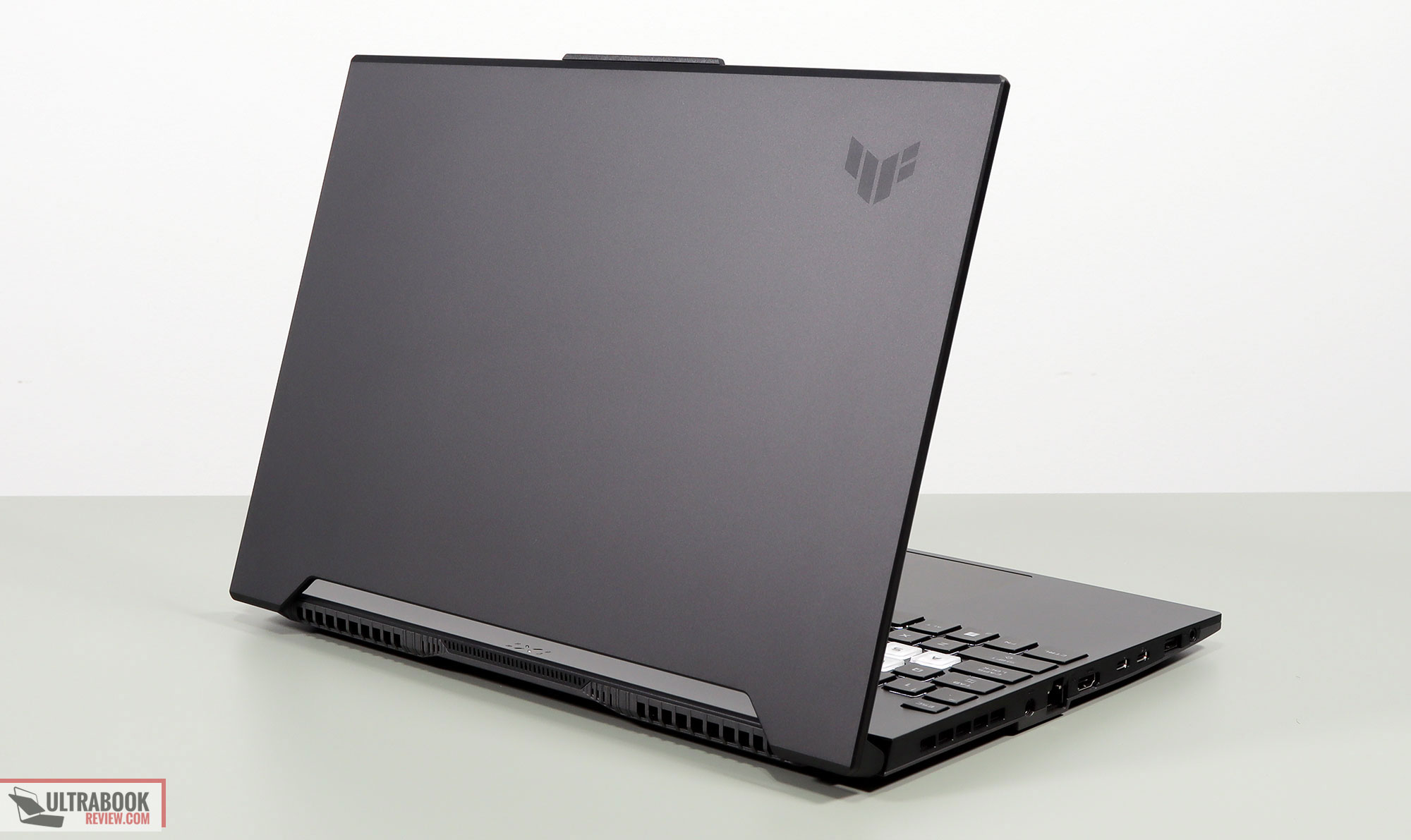
The interior is this matte smooth plastic, just like on the regular TUFs, and the lid is made out of aluminum. Both surfaces feel good to the touch, but they also show smudges easily, so you’ll constantly have to clean them out.
The laptop is also sturdy and well made, and I haven’t noticed any weird noises or creaks during my time with it. At the same time, it is a bit thinner and lighter than the average mid-ranged 15-inch laptop, at just under 2 kilos for this tested configuration.
As far as the practicality of this design goes, I find it to be a mixed bag. On one hand, I like the grippy rubber feet and the strong feel of the chassis, as well as the sturdy hinges that keep the screen in place as set-up, without it wobbling or moving. On the other, I find the front lip and corners to be harsh on the wrists, and I just don’t understand why Asus keep putting bright status LEDs under the screen – in fact, with this generation, they’re even brighter and more annoying than before when using the laptop in the dark. Then, there’s also the fact that the screen only goes back to about 150 degrees, and not all the way flat, as I’d preffer on a portable-wannabe design.
The ports are lined on the sides, mostly on the left and towards the front of the laptop, which is going to clutter out that area if you plan to connect many peripherals.
As a novelty for the 2022 model, the laptop comes with two USB-C ports. One of them is data only, and the other supports Thunderbolt 4 with video (dGPU connection) and charging (up to 100W). The HDMI port hooks into the dGPU as well, but is only 2.0b.
Overall, the Dash F15 is a nice looking and versatile design, but it does show its budget matter here and there, and comes with some practical quirks that might steer some of you away.
Keyboard and trackpad
The keyboard on the 2022 Dash F15 is identical to the keyboards on the TUF Gaming models, but only comes with white backlighting, not RGB.
It’s a fair layout with a NumPad section and an extra set of multimedia keys at the top-left. The keycaps feel nice to the touch and are somewhat smudgy, and the overall feedback is firmer than on older TUF generations, and overall ensures this is a fair typer that should cater well to most needs and preferences.
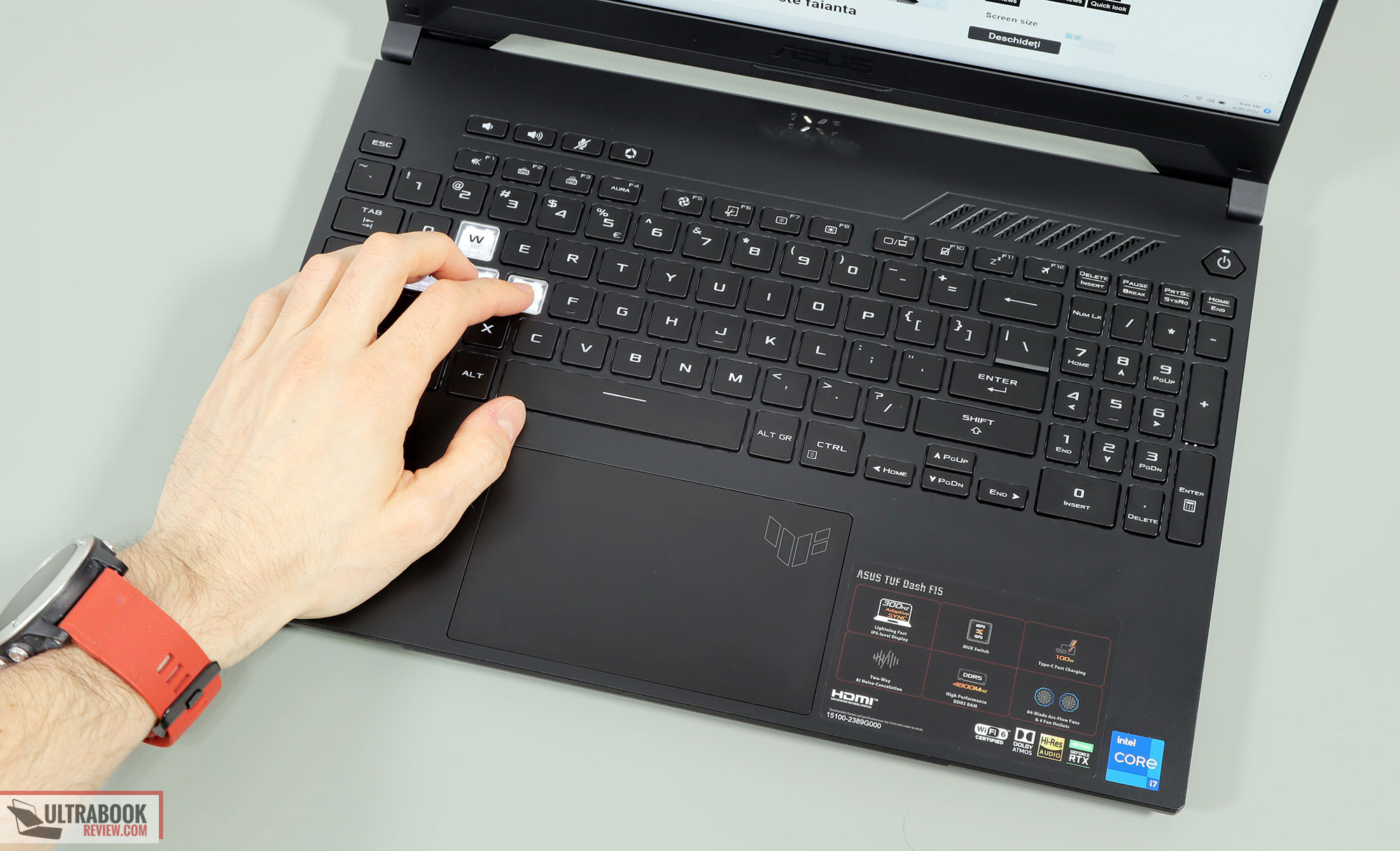
The illumination is uniform and bright enough at the maximum level. Some light creeps out from underneath the keycaps, though, especially because they are designed with translucent sides meant to allow the light to shine through. Asus also allow the ability to reactivate the lighting with a swipe over the clickpad once it times off, and made sure to implement a dedicated Caps-Lock indicator.
Asus have slightly updated the inputs on this 2022 TUF Gaming series, revamping the layout, adding an extra set of media keys at the top-left which were previously only available on ROG laptops, as well as a larger clickpad.
They still went with a full layout with a NumPad section, and mostly everything is in the right place. The NumPad keys are narrower than the main deck of keys, and the arrows keys are wider than before, but at the same time shorter and more cramped within everything else. Overall, though, this is a fair layout.
For mouse, there’s a 25% larger clickpad-style surface on this TUF Dash generation. It feels a lot like the clickpads on the higher-tier Asus products, but is made out of smooth plastic, not glass, and I found it snappy and consistent during my time with the laptop. It’s also a very solid implementation that doesn’t rattle with taps, and somehow even the physical clicks in the corners are quieter than on the TUF Gaming A15 tested a few weeks ago.
As for biometrics, there are still none on the TUFs.
Screen
Asus offers a couple of screen options for this 2022 TUF Dash F15 lineup, all 15.6-inch, 16:9, matte and non-touch:
- FHD 144Hz with 300+ nits of brightness and 65% sRGB colors;
- FHD 300Hz 3ms with 300+ nits of brightness and 100% sRGB colors;
- QHD 165Hz 3ms with 350+ nits of brightness and 100% DCI-P3 colors.
The FHD 144hz option is most likely the rather dull and slow Chi Mei panel available with past entry-level TUFs (we’ve reviewed it here). The FHD 300Hz is a nicer mid-range option, while the QHD panel is what I’d recommend for multi-purpose use in this class of notebooks, especially if you’re opting for the higher-tier specs.
We’ve reviewed the QHD panel in the TUF A15 over here, and on this Dash F15 sample, we have the mid-range FHD 300Hz panel. In comparison to the QHD, this FHD option is not as sharp, being a lower resolution panel, and only covers 70% of the DCI-P3 gamut. However, max brightness is similar between the two, at around 350-nits, and the blacks and contrast are superior for the FHD panel.
Furthermore, this FHD option is 300 Hz refresh rate and slightly faster in response times than the QHD, so arguably a somewhat better gaming option, especially for fast-paced competitive titles running at high framerates; there’s no GSync implemented, only Adaptive-Sync to prevent tearing.
Here’s what we got in our tests, with an X-Rite i1 Display Pro sensor:
- Panel HardwareID: Sharp TL156VDXP010;
- Coverage: 97.7% sRGB, 68.7% AdobeRGB, 70.6% DCI-P3;
- Measured gamma: 2.12;
- Max brightness in the middle of the screen: 352.99 cd/m2 on power;
- Min brightness in the middle of the screen: 15.75 cd/m2 on power;
- Contrast at max brightness: 1261:1;
- White point: 6600 K;
- Black on max brightness: 0.28 cd/m2;
- PWM: No.
Calibration is pretty good out of the box, with minimal skewness in Gamma and White Point. Once further calibrated, this panel ended up uniform in luminosity and color, and I also haven’t noticed any obvious screen-bleeding on black backgrounds.
Hardware and performance
Our test model is a mid-specced configuration of the 2022 ASUS TUF Dash F15 series, code name FX517ZM, built on an Intel Core i7-12650H processor, 16 GB of DDR5-4800 memory in dual channel, 1 TB of SSD storage, and dual graphics: the Nvidia RTX 3060 dGPU with 6 GB of vRAM and the Intel Iris iGPU integrated within the Alder Lake platform.
Disclaimer: Before we proceed, keep in mind that our review unit was sent over by Asus and it runs on the software available as of late-April 2022 (BIOS 312, Armoury Crate 5.1.4, GeForce 511.79 drivers). This is a mature software package, as the laptop has been available in stores for a few months now, but some aspects might still change with later updates.
Spec-wise, the 2022 Dash F15 series is built on the latest Intel and Nvidia hardware available to date. The Intel Core i7-12650H is a mid-range 12th gen Alder Lake processor, with 10 Cores and 16 Threads. It is a hybrid CPU with 6 High-Performance Hyper-Threaded Cores, and 4 extra Efficiency cores, working together or separate based on demand. The design of this Dash F15 allows the processor to run at 65+W of sustained power in demanding CPU loads, on the Turbo profile.
For the GPU, the 2022 Dash F15 series is available with RTX 3000 and RTX 3000 Ti graphics chips. What we have on this sample is an RTX 3060 running at up to 105W with Dynamic Boost in supported games and applications.
For the RAM and storage options, the laptop offers two accessible memory DIMMs and two M.2 SSD slots. Our unit shipped with 16 GB of DDR5-4800 RAM in dual-channel and a single PCIe gen3 SSD. This is fine for most requirements and can be upgraded to gen4 drives if you need faster storage. Asus only offers the series with gen3 storage out of the box, for price-cutting reasons.
Accessing the components requires removing the back panel, which is held in place by a couple of Philips screws. These screws are of different sizes, so be careful about putting them back. You’ll need a prying tool, as the back panel is attached snugly with strong plastic clips. I suggest starting from the front corner where the pop-out screw is placed, and then working your way around the edges.
Inside you’ll find all the components, the battery, the speakers, and the thermal module. There’s some unused space around the battery, but everything else is packed up tightly with this design.

Specs aside, Asus offer their standard four power profiles in the Armoury Crate control app for this laptop: Silent, Performance, Turbo, and Manual, with various power settings and fan profiles between them.
- Silent – quite fan-noise at under 35 dB, limited CPU/GPU speeds and power;
- Performance – balanced profile with stock CPU/GPU settings and ~40 dB fan noise;
- Turbo – High-Performance profile with increased CPU power allocation, faster-spinning fans at ~49 dB, and overclocked GPU (+50 MHz Core/+100 MHz Memory, up to 105W TGP).
- Manual – like Turbo, but with the ability to custom tweak the CPU’s PL1/PL2 power levels and GPU’s power/clocks, plus create custom fan profiles based on temperature limits.
Manual mode has been added to the TUF Gaming lineup this generation, allowing for extra control over the fans and CPU/GPU power settings, just like on the Asus ROG devices. This was not available for the TUFs in previous years.
Turbo is only available with the laptop plugged into the wall and is meant for gaming and other demanding loads. Performance is a jack-of-all-trades, while Silent is made for light daily use. The system is able to idle the fans on the Silent profile as long as the CPU/GPU stay under 60 degrees C, leading to a mostly noiseless daily-use experience.
Here’s what to expect in terms of performance and temperatures with everyday multitasking, browsing, and video.
Performance and benchmarks
On to more demanding loads, we start by testing the CPU’s performance by running the Cinebench R15 test for 15+ times in a loop, with a 1-2 seconds delay between each run.
The Core i7 processor stabilizes at ~65W of sustained power on the Turbo setting, with temperatures of ~95 C, and scores of ~2000 points. The fans spin at ~49 dB at head-level in this mode, but they take a little time to react to the Cinebench load, which explains the drop in scores after a few loads, which is then corrected in the later runs.
That aside, the CPU is thermally limited on this profile, which causes the power to drop to the 65W sustained level, despite the fact that the PL1 setting is 75W for this Turbo mode. The cooling design is unable to run the processor at that sustained level, though.
There’s no undervolting option in the BIOS, so there’s no way to tweak the CPU at this point.
Opting for the Manual mode with max rpm fans doesn’t make any difference here, as the fans are already running at maximum speeds on Turbo.
Switching over to the Performance profile translates in the CPU stabilizing at ~55W and temperatures in the mid-90s, but with the fans spinning much quieter at ~40 dB at head-level. The CPU is power and thermally limited in this mode, but able to run at the designed PL1 limit of 55W, and able to return scores of ~1850 points, just 10% lower than on Turbo/Manual.
The Silent profile limits the sustained power at 26W, with barely audible fans (sub 30 dB) and middling temperatures (low-70s C). The Core i7-12650H scores ~1200 in this mode, roughly 60% of the Turbo performance, which is not bad for this kind of profile.
Finally, the CPU runs at ~45 W on battery, on the Performance profile, with stabilized scores of around 1700 points. That’s solid for battery use. Details below.
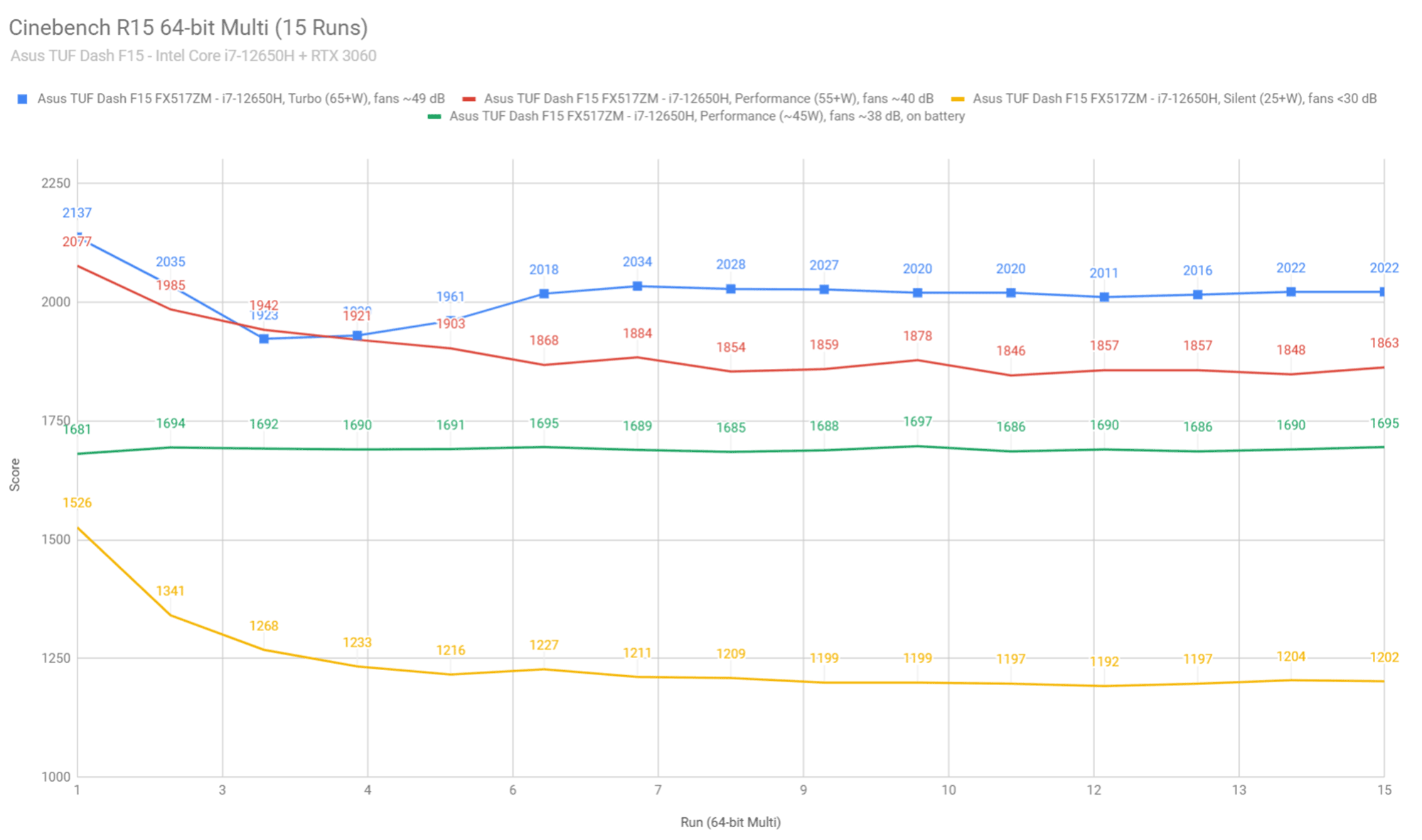
To put these in perspective, here’s how this Core i7-12650H implementation fares against other competing platforms in this test, both Intel and AMD. The 2022 Intel i7-12700H and AMD Ryzen 7 6800H mainstream options with a higher core count are outmatching this by a fair degree, but at the same time, this is very competitive against 6C Intel/AMD 2021 platforms, and ~2x the performance of the 4C Core i7-11370H Intel hardware available in the 2021 Dash F15 series.
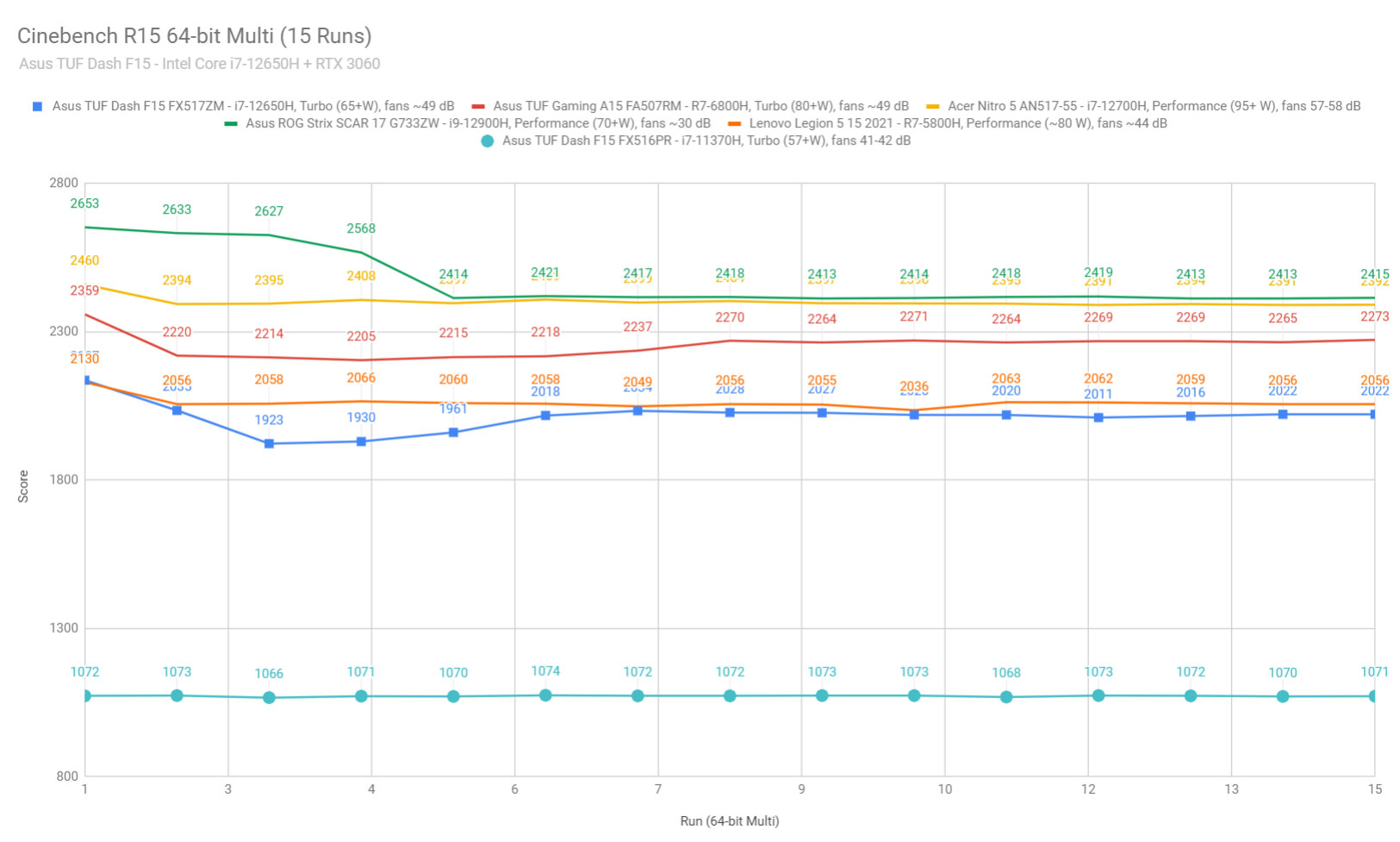
We then went ahead and further verified our findings with the more taxing Cinebench R23 loop test and Blender – Classroom, which resulted in similar findings to what we explained above. Silent mode was an exception in Cinebench R23, though, with the CPU running at ~45W sustained in this case.
We also ran the 3DMark CPU test on the Turbo profile.
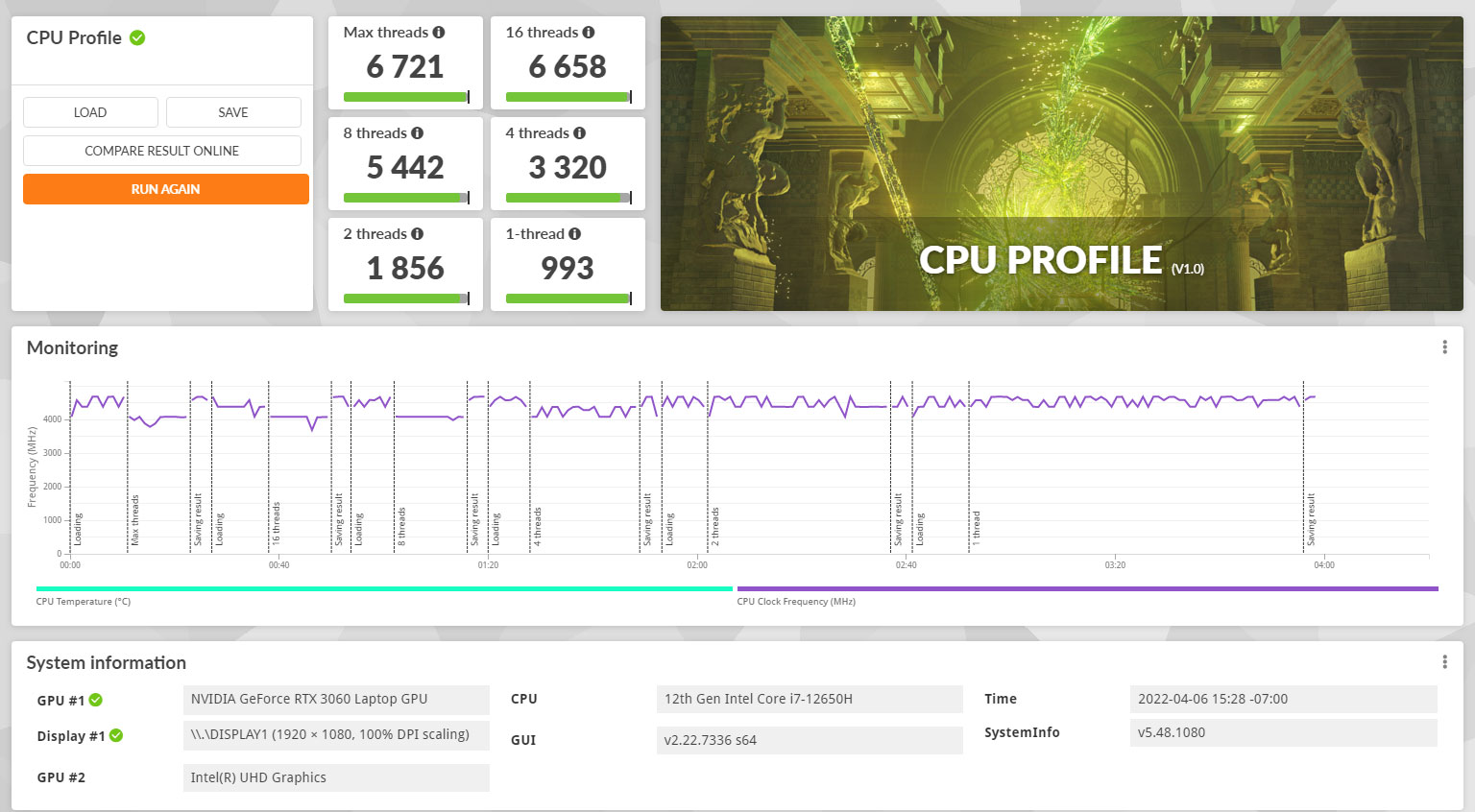
Finally, we ran the combined CPU+GPU stress tests on this notebook. 3DMark stress runs the same test for 20 times in a loop and looks for performance variation and degradation over time, and this unit easily passed, which means there’s no performance throttling with longer-duration sustained loads.
Next, we ran the entire suite of tests and benchmarks, on the stock Turbo profile in Armoury Crate, the MUX set on Hybrid mode, and on FHD screen resolution for consistency with our other tests.
- 3DMark 13 – Fire Strike: 19030 (Graphics – 20967, Physics – 26516, Combined – 8992);
- 3DMark 13 – Port Royal: 4854;
- 3DMark 13 – Time Spy: 8327 (Graphics – 8037, CPU – 10472);
- Uniengine Superposition – 1080p Extreme: 5007;
- Uniengine Superposition – 1080p Medium: 14825;
- Handbrake 1.3.3 (4K to 1080p encode): 53.37 average fps;
- PassMark 10: Rating: 5207 (CPU: 22092, 3D Graphics: 15329, Memory: 2813, Disk Mark: 15699);
- PCMark 10: 7073 (Essentials – 10545, Productivity – 9419, Digital Content Creation – 9671);
- GeekBench 5.4.3 64-bit: Single-Core: 1768, Multi-core: 10703;
- CineBench R15 (best run): CPU 2137 cb, CPU Single Core 260 cb;
- CineBench R20 (best run): CPU 5173 cb, CPU Single Core 690 cb;
- CineBench R23: CPU 13562 cb (best single run), CPU 13121 cb (10 min run), CPU Single Core 1791 cb;
- x265 HD Benchmark 64-bit: 29.77 s.
And here are some workstation benchmarks, on the same Turbo profile:
- Blender 3.01 – BMW scene – CPU Compute: 3m 02s (Turbo);
- Blender 3.01 – BMW scene – GPU Compute: 29s (CUDA), 15s (Optix);
- Blender 3.01 – Classroom scene – CPU Compute: 7m 04s (Turbo);
- Blender 3.01 – Classroom scene – GPU Compute: 58s (CUDA), 33s (Optix);
- Pugetbench – DaVinvi Resolve: 993;
- Pugetbench – Adobe Afert Effects: 863;
- Pugetbench – Adobe Photoshop: 837;
- Pugetbench – Adobe Premiere: 873;
- SPECviewperf 2020 – 3DSMax: 76.81 (Turbo);
- SPECviewperf 2020 – Catia: 50.15 (Turbo);
- SPECviewperf 2020 – Creo: 86.09 (Turbo);
- SPECviewperf 2020 – Energy: 19.37 (Turbo);
- SPECviewperf 2020 – Maya: 270.29 (Turbo);
- SPECviewperf 2020 – Medical: 24.88 (Turbo);
- SPECviewperf 2020 – SNX: 16.24 (Turbo);
- SPECviewperf 2020 – SW: 177.02 (Turbo).
- V-Ray Benchmark: CPU – 9410 vsamples, GPU CUDA – 828 vpaths, GPU RTX – 1102;
These are competitive scores for a mid-range laptop.
Compared to last year’s Dash F15 series (the i7 + RTX 3070 version), we’re looking at 50-100% superior CPU performance in multi-threaded loads and 10-20% gains in single-core loads. As for the GPU performance, the 3060 in the 2022 configuration is within 10% of the performance of last year’s 3070 in benchmarks, and about on par or even superior in certain workloads and in games, thanks to the addition of a MUX to the 2022 model.
At the same time, this i7-12650H is not as fast as an Intel i7-12700H pr a Ryzen 7 6800H implementation, the kind you will find on many other mid-tier laptops with slightly thicker and heavier builds.
The differences aren’t significant, though, somewhere around 15-25% in multi-threaded loads, with similar scores in single-core chores. They’re both a result of the higher amount of Performance cores available with those Core/Ryzen H platforms, but also a consequence of the fact that those thicker products are able to run the hardware at higher sustained power in demanding loads.
The same can be concluded on the GPU performance, where this lower-power implementation is not a match for the 130-150W options available in full-size mid-tier products. But the differences you should expect are still within 15-20% in GPU loads and games, so not necessarily a deal-breaker for the average user.
Thus, if the CPU multi-threaded and GPU performance are decisive for your requirements, I’d recommend going with one of those thicker units over this TUF Dash, in devices such as the TUF Gaming A15/F15, the Acer Nitro 5, or the Lenovo Legion 5 lineups. Otherwise, if you’re fine sacrificing performance to some extent for a more portable product and a lower price, this Dash F15 series is a lot more competitive in this 2022 generation than its predecessor was last year.
Gaming performance
Let’s see how this 2022 TUF Dash F15 notebook handles modern games.
We tested several games at FHD resolution on Ultra settings, on the stock Turbo and Performance profiles. I’ve also included Silent mode, for a quiet sub-35dB gaming experience, and Manual mode with maxed-out fans and a few tweaks that I’ll explain further down.
Intel Core i7-12650H
+ RTX 3060 Laptop 80-105W
FHD Turbo
FHD Manual
FHD Performance
FHD Silent
Battlefield V
(DX 12, Ultra Preset, RTX OFF)
129 fps (65 fps – 1% low)
125 fps (54 fps – 1% low)
117 fps (51 fps – 1% low)
106 fps (57 fps – 1% low)
Cyberpunk 2077
(DX 12, Ultra Preset, RTX OFF)
57 fps (45 fps – 1% low)
–
52 fps (41 fps – 1% low)
–
Doom Eternal
(Vulkan, Ultra Preset)
175 fps (126 fps – 1% low)
–
183 fps (125 fps – 1% low)
–
Far Cry 6
(DX 12, Ultra Preset, TAA)
82 fps (57 fps – 1% low)
82 fps (55 fps – 1% low)
82 fps (59 fps – 1% low)
76 fps (52 fps – 1% low)
Far Cry 5
(DX 11, Ultra Preset, SMAA)
118 fps (82 fps – 1% low)
107 fps (80 fps – 1% low)
109 fps (79 fps – 1% low)
104 fps (82 fps – 1% low)
Metro Exodus
(DX 12, Ultra Preset, RTX OFF)
61 fps (40 fps – 1% low)
–
–
–
Red Dead Redemption 2
(DX 12, Ultra Optimized, TAA)
90 fps (62 fps – 1% low)
–
76 fps (52 fps – 1% low)
–
Shadow of Tomb Raider
(DX 12, Highest Preset, TAA)
105 fps (80 fps – 1% low)
98 fps (72 fps – 1% low)
87 fps (68 fps – 1% low)
84 fps (66 fps – 1% low)
The Witcher 3: Wild Hunt
(DX 11, Ultra Preset, Hairworks On 4)
105 fps (70 fps – 1% low)
106 fps (74 fps – 1% low)
97 fps (65 fps – 1% low)
82 fps (53 fps – 1% low)
- Battlefield V, Cyberpunk, Doom, Witcher 3 – recorded with Fraps/in-game FPS counter in campaign mode;
- Far Cry 5, 6, Metro, Red Dead Redemption 2, Tomb Raider games – recorded with the included Benchmark utilities;
- Red Dead Redemption 2 Optimized profile based on these settings.
Those above are rasterization tests, and here are some results for RTX titles with and without DLSS.
Intel Core i7-12650H + RTX 3060 Laptop 80-105W
FHD Turbo
Battlefield V (DX 12, Ultra Preset, RTX ON, DLSS OFF)
83 fps (56 fps – 1% low)
Battlefield V (DX 12, Ultra Preset, RTX ON, DLSS ON)
90 fps (54 fps – 1% low)
Cyberpunk 2077 (DX 12, Ultra Preset + RTX, no DLSS)
27 fps (22 fps – 1% low)
Cyberpunk 2077 (DX 12, Ultra Preset + RTX, DLSS Balanced)
56 fps (44 fps – 1% low)
Doom Eternal (DX 12, Ultra Preset, RTX ON, DLSS Quality)
N/A
Far Cry 6 (DX 12, Ultra Preset + DXR reflections / shadows)
69 fps (39 fps – 1% low)
Shadow of Tomb Raider (DX 12, Highest Preset, TAA, RTX Ultra)
58 fps (34 fps – 1% low)
This configuration can handle most modern games at FHD resolution and Ultra settings, with some exceptions once you activate RT, due to the only 6 GB of VRAM on the RTX 3060 chip. QHD resolution should also work fine with most titles, but you’ll have to trim down the details in some of the recent AAA games.
Compared to last year’s Dash F15 in the i7 + RTX 3070Ti configuration, this lower GPU-specced 2022 model is able to score up to 20% higher in games, as a result of eliminating the CPU bottleneck, of the faster RAM, and of the implemented MUX, which plays a noticeable role in games.
Compared to the R7 + RTX 3060 140W configuration of the full-size TUF Gaming A15, this i7 + RTX 3060 105W Dash F15 ends up only within 2-10% slower in the tested games. I was expecting a bigger gap given the 35W difference in maximum GPU power between the two, but the superior IPC and higher single-core clocks of the i7 processor vs the Ryzen 7 6000 platform seem to play a role in the gaming performance as well.
It would be very interesting to compare this Dash F15 to the Intel-based TUF Gaming F15 FX507 series with the i7-12700H + RTX 3060 140W processor, which we’ve also reviewed in the meantime. It outmatches the Dash F15 by a fair amount in both the CPU and GPU performance.
With these out of the way, let’s go over some performance and temperature logs, which are going to better explain some of our findings above.
On Turbo and with the current BIOS settings, this laptop runs the CPU at ~20W in the titles that scale well onto the GPU with Dynamic Boost, such as Witcher, Cyberpunk on Red Dead, and ~30W in those that don’t, such as the Far Cry titles or Battlefield V. As a result, the CPU averages temperatures in the mid-70s at 20W, but goes in the mid and high 80s at 30+W. Both scenarios are within the acceptable limits for a mid-range design such as this one.
Since the Turbo mode is designed to offer ~125W of sustained combined CPU+GPU power in this laptop, that means the GPU scales in power between up to 105W in Witcher and Red Dead, and down to 80W of power in the Far Cry titles. We’re looking at temperatures between 82-85 degrees Celsius at the higher power settings, and around 80s in the other titles.
All in all, the CPU temperatures are fine for this design, while the GPU does run on the hotter side once pushed towards the maximum 105W of possible power with Dynamic Boost. At the same time, I’m not seeing any thermal throttling in games here. Check out the logs for more details.
Bumping up the back of the laptop from the desk in order to improve the airflow into the fans plays a role here, shedding 2-5 degrees off the components. That’s because the low-profile rubber feet implemented on this laptop choke the intakes to some extent. Opting for an active cooling pad will help even more.
As a novelty for the 2022 TUFs, there’s now the Manual mode available in Armoury Crate, which allows customizing the fan profiles and CPU/GPU settings. I’ve set the fans at max 100% rpms, as well as applied these CPU and GPU settings:
- CPU: PL1 – 22W, PL2 – 40W (to encourage power shifting to the GPU), fans set at 100% rpm for temperatures over 50C.
- GPU: the same +50MHz Core and +100 MHz memory overclock (there’s room for further tweaking here), fans set at 100% for temperatures over 50C.
This profile doesn’t do anything in those titles that already scaled well with Dynamic Boost, but it does help a little bit in the Far Cry titles, as it allows the GPU to run at slightly shower power and clocks with the hard PL limit.
Here are the logs for Manual mode with the laptop on the desk.
And with the back bumped up to improve the airflow.
With all these high-performance profiles out of the way, if you’re looking for quieter noise levels when running games, your options are either the Performance mode, the Silent mode, or a further tweaked Manual profile with custom fan profiles and a GPU thermal limit setting.
On Performance, the fans spin much quieter at up to 42 dB, and the framerates take an up to 20% hit compared to the Turbo mode. That’s not a result of high internal temperatures, as on the regular TUF Gaming models, but a result of the fact that the Performance mode puts an 85W power limit on the GPU, which plays a greater or smaller role between the tested titles, based on their ability to scale up with Dynamic Boost.
The Silent mode aggressively limits the GPU on this laptop, leading to CPU/GPU temperatures of 70-75 C and fan noise levels of sub 35 dB. Most games are still going to run OK with Whisper Mode activated, with or without a fps limit, but you’ll want to switch medium graphics settings for 60+ fps in the recent titles.
Lastly, this laptop can also run games on battery on the Performance profile, with a 60 fps limit set in the settings. It performs much as on the Silent plugged-in mode detailed above. Don’t expect more than one hour of gameplay at full details, or perhaps longer with a 30 fps cap and lower settings.
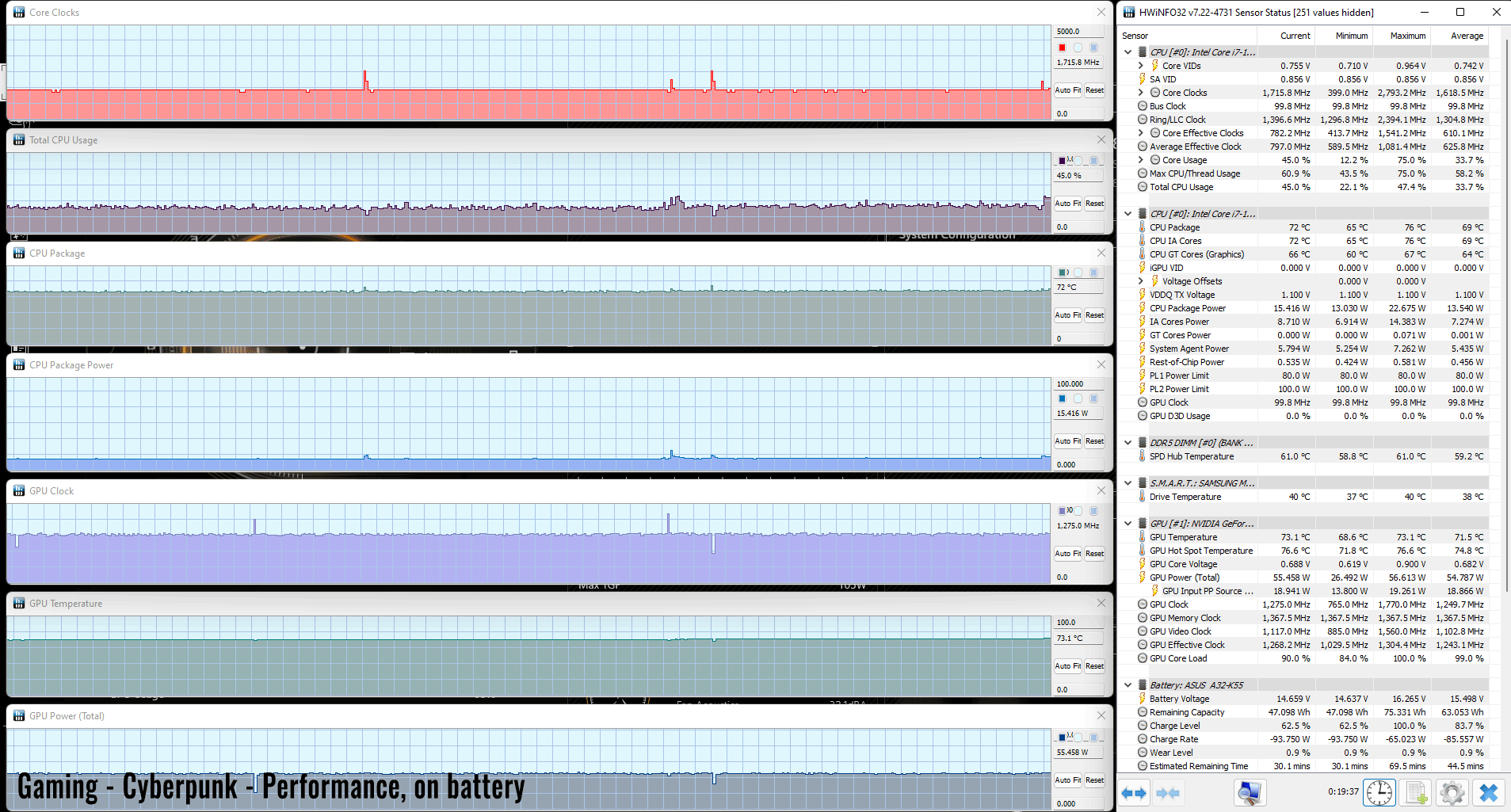
All in all, the 2022 Asus TUF Dash F15 series is a lot more capable than the previous generation, and actually a solid performer in the mid-range class. Sure, it’s not on par with the thicker and heavier full-size options, but it comes within 10- 25% of their capabilities in CPU-heavy workloads and within 10-15% of what they can do in games and GPU loads, all those in a more portable format and in a more affordable package. I would still recommend either bumping up the back of the laptop in order to increase the airflow into the fans, or buying yourself a proper cooling pad to further help keep those temperatures at bay. Both are going to make a difference here.
Noise, Heat, Connectivity, speakers, and others
The internal cooling design of the 2022 TUF Dash series is pretty much identical to what Asus used in the past, and a derivative of their 15-inch Zephyrus cooling modules.

The bump in CPU/GPU power from the 2021 model does lead to slightly higher internal temperatures, and even if the GPU does run in the mid 80s in some cases, I haven’t noticed throttling or overheating issues.
You’ll still want to bump up the back of the laptop in order to improve the airflow of fresh air into the fans, as the rubber feet tend to choke up the intakes to some extent, as their design forces the fans to draw fresh air from the middle of the laptop, and not from the laterals where it would be able to easier get access cooler air.
Now, as far as the outer case temperatures go, these are fine on all modes, with a hotter spot in the low 50s C in the middle of the chassis and temperatures in the mid-30s to low-40s on the keyboard deck. The temperatures are even lower on the Performance mode, as a result of the capped GPU power, which makes this mode a good middle-grounder, paired with the quieter fans (~42 dB vs up to 49 dB on Turbo and up to 50 dB on Manual).
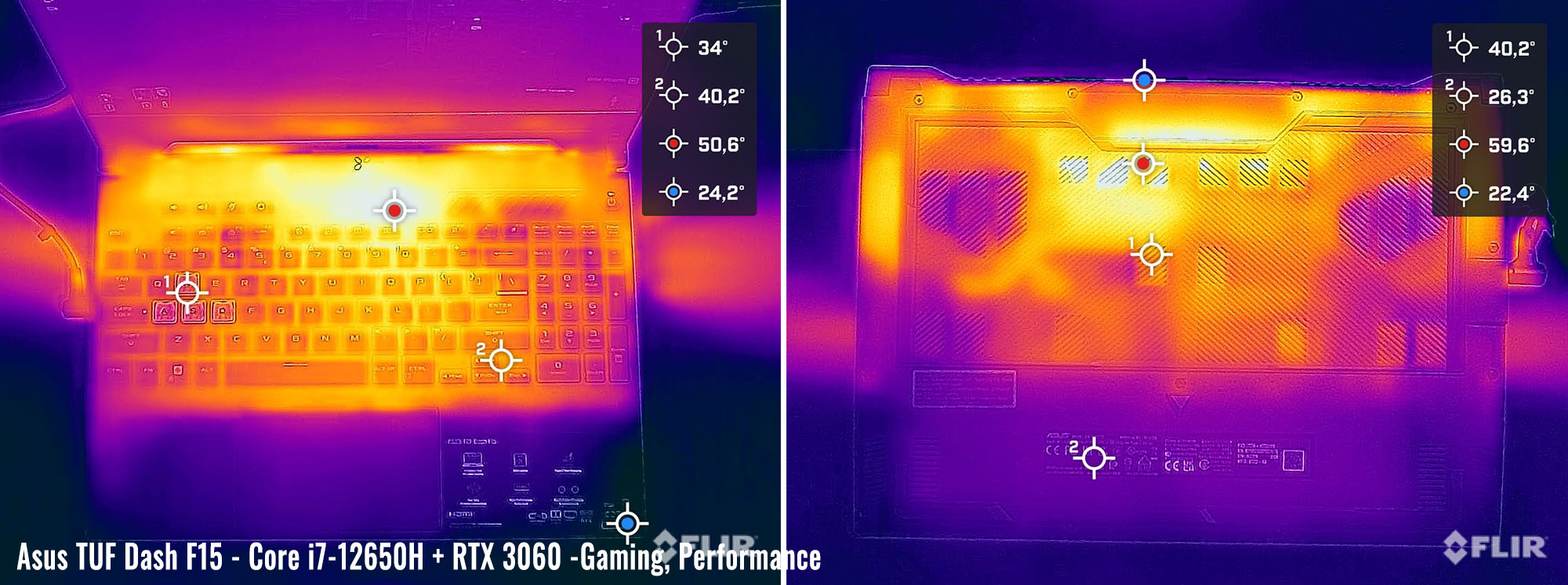
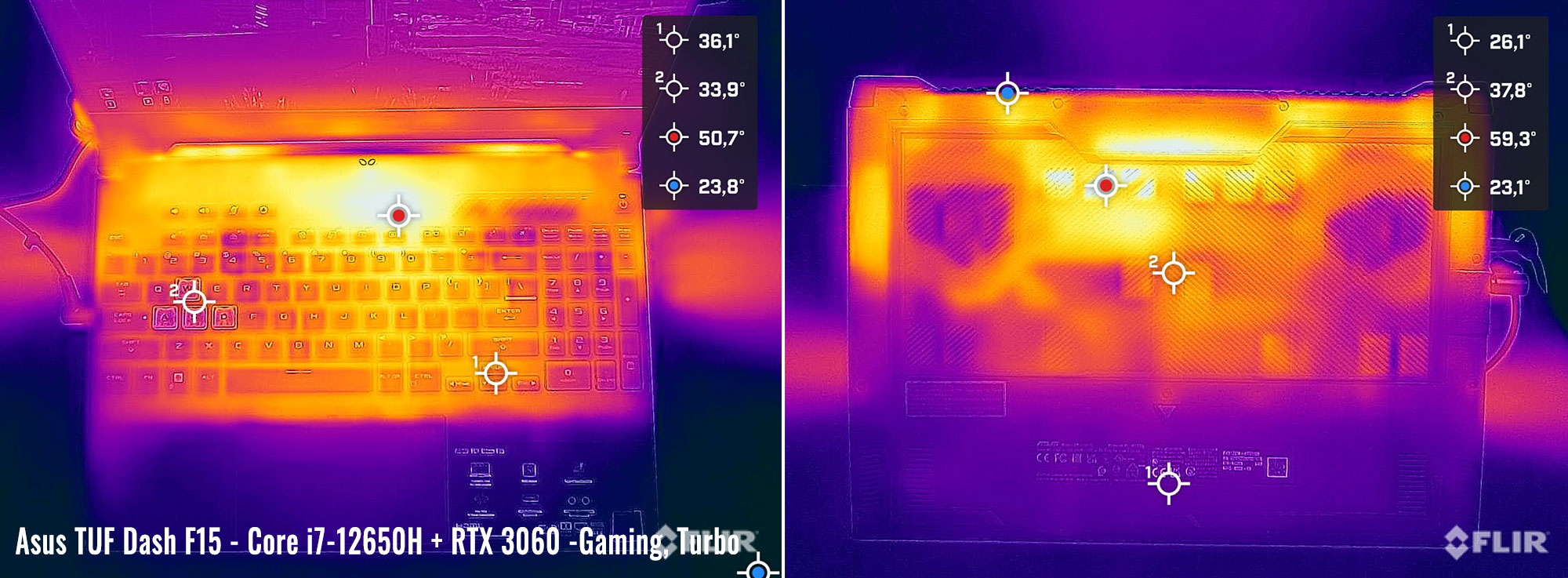
*Gaming – Performance – playing Far Cry 5 for 30 minutes, fans at ~41-42 dB
*Gaming – Turbo, on desk – playing Cyberpunk 2077 for 30 minutes, fans at ~49 dB
At the same time, this laptop is a breeze with everyday use, multitasking, browsing, or video streaming. The 0dB Technology allows the two fans to completely switch off with light use as long as the hardware stays under 60 C on the Silent profile, which is most of the time. And that’s both on battery or when plugged in.
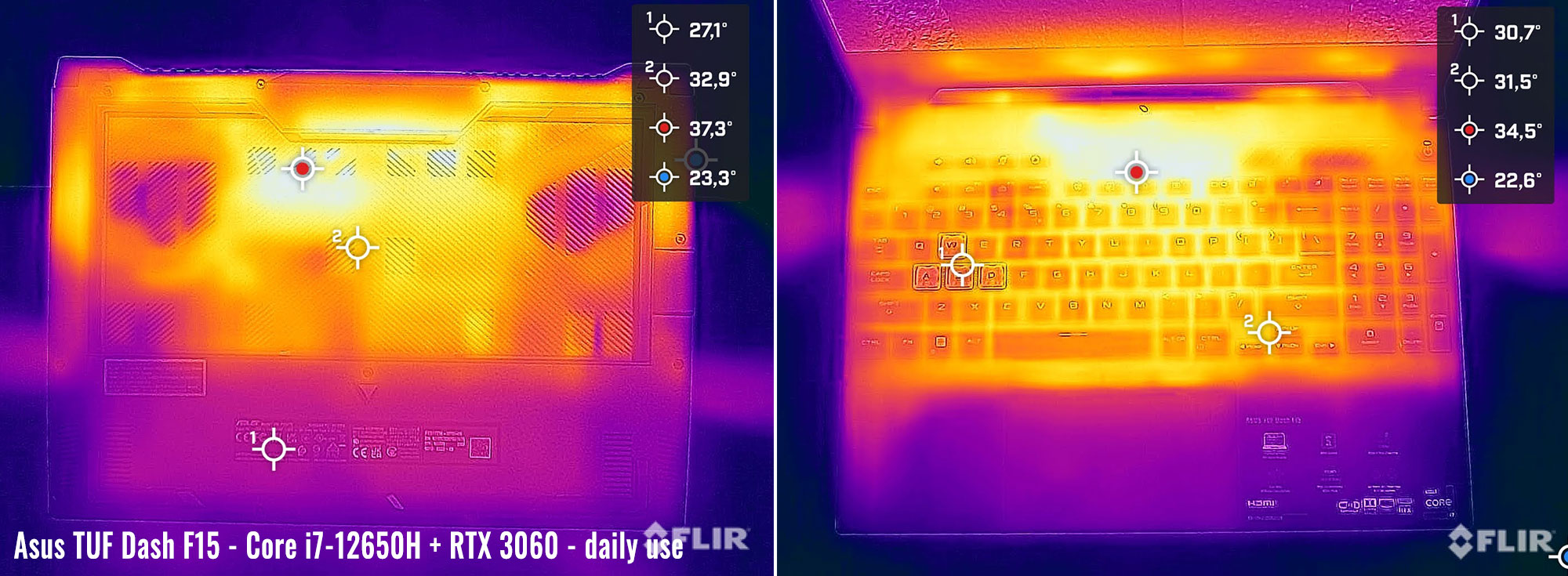
*Daily Use – streaming Netflix in EDGE for 30 minutes, Silent profile, fans at 0 dB
For connectivity, there’s Wireless 6 and Bluetooth 5 on this unit, as well as Gigabit Lan, but not Wifi 6E or 2.5G Lan as on the 2022 ROG products. Not a problem IMO, and I have no complaints about the included Intel chip, which proved fast and reliable for everyday use.
The audio quality here is alright for this class of budget performance laptops, with two speakers firing on the bottom and to the sides. The sound lacks plenty in the lows, but it’s OK for daily use, especially if you make sure to tick the “Enhanced Optimus” option in the Speakers menu in Windows 11. This audio system is very similar to what Asus put in their TUF Gaming full-size lineup, with volumes peaking at about 75-76 dB at head level, and without noticeable distortions or vibrations in the chassis at high volumes.
Finally, the camera is placed on top of the screen, flanked by microphones. There wasn’t any of the 2021 Dash, so this is a major update. It’s OK for occasional calls in a well-lit room, but don’t expect much in quality.
Battery life
There’s 76 Wh battery inside the 2022 TUF Dash F15 models, a bit smaller than the norm for a mid-range 15-inch notebook, but acceptable for a thinner-and-lighter design.
The system automatically switches the screen’s refresh to 60 Hz when using the laptop on battery, to increase efficiency, and that’s the quick screen flicker that you’ll notice when disconnecting the laptop from the wall. Also, if you’re looking to maximize runtimes, make sure to use the laptop in the Hybrid MUX mode.
Here’s what we got on our review unit in terms of battery life, with the screen’s brightness set at around 120 nits (~60 brightness) and on Hybrid mode.
- 13.5 W (~5-7 h of use) – text editing in Google Drive, Silent Mode, screen at 60%, WiFi ON;
- 12 W (~7-8 h of use) – 1080p fullscreen video on Youtube in Edge, Silent Mode, screen at 60%, WiFi ON;
- 11.5 W (~8-9 h of use) – Netflix fullscreen in Edge, Silent Mode, screen at 60%, WiFi ON;
- 16 W (~4-6 h of use) – browsing in Edge, Performance Mode, screen at 60%, WiFi ON;
- 85 W (~1 h of use) – Gaming – Witcher 3, Performance Mode, screen at 60%, WiFi ON, no fps limit.
These are alright runtimes for an Intel 12th gen platform, better than the 14C i7/i9 options we’ve tested in the past, and about on par with the Ryzen 7 6800H implementation in the TUF Gaming A15.
This F15 configuration comes with a compact 200W power brick, the version with two long thick cables. The battery fills up in under 2 hours, with fast charging for the first half an hour.
USB-C charging is supported as well, as a novelty for the 2022 generation, up to 100W. You won’t be able to use the laptop on Turbo while hooked over USB-C, but that’s enough for everyday multitasking and occasional heavy workloads on Performance, in case you don’t want to bring along the heavier main brick when traveling.

Price and availability- 2022 ASUS TUF Dash F15
The 2022 Asus TUF Dash F15 lineup is listed in most regions at the time of this article.
The F15 FX517ZM configuration tested here, with the Core i7 + RTX 3060 specs, is available for under $1199 USD in the US, 1250 EUR in Europe, and 1300 GBP in the UK.
Most of these are with 16 GB of RAM, 512 GB or 1 TB of storage, and with the FHD 144Hz display, though, which I’d be very careful about, as it is dimmer, slower and more washed out that the FHD 300Hz option on our review unit. Make sure you’re aware of these shortcomings and get the laptop from places that allow returns, in case you decide that panel is not good enough for your needs.
The FHD 300 Hz screen configuration is available around here as well, for a roughly ~100 EUR premium over the 144Hz FH configurations. Furthermore, I could also find the Dash F15 FX517ZE (i7 + 3050Ti + FHD 144HZ display) starting at around 1200 EUR, and the Dash F15 FX517ZR (i7 + 3070Ti +FHD 300Hz display) starting at ~1700 EUR. The ZR is also available in the US, for $1499 at Best Buy, but with the same 144Hz display.
I still think the best value for this series is in the i7 + RTX 3060 models, but I’d look for configurations with the 300Hz FHD or the 165Hz QHD panels as much as possible. I’d also expect some price cuts later on, as time goes by.
We’ll update you when we know more. In the meantime, follow this link for updated configurations and prices in your region at the time you’re reading this article.
Final thoughts- 2022 ASUS TUF Dash F15 review
The Dash F15 is Asus’s most affordable all-around/gaming laptop series this year, and although not without some quirks, I found it to be a good multi-purpose computer during these last few weeks that I’ve used it for this review.
As far as the performance goes, this 2022 generation is a lot more capable than the 2021 model. Asus updated the CPU options and the RAM, upped the GPU power, and added a MUX, and all these make for a significant difference with demanding workloads and games. In fact, this i7 + 3060 configuration scored better than I was expecting in our benchmarks and gaming tests, compared to the more powerful TUF Gaming A15 recently reviewed.
Nonetheless, this does sacrifice on performance to some extent for a thinner and lighter construction. It also cuts some corners when it comes to practicality, with the annoyingly placed status LEDs, sharp edges and the IO squeezed together on the left edge, and not spread more conveniently around all sides and the back. It’s going to be up to you to accept these inconveniences or go with something else if you cannot.
I must also touch on the screen options available for this series. As of right now, late-April 2022, the majority of the Dash F15 configurations available in stores come with the FHD 144 Hz display, which is a subpar panel by today’s standards with 70% sRGB color coverage and slow response times. Sure, those configurations are competitively priced for 2022 specs, but the screen quality is very important to me and I’d rather go with an older 2021 model and a better screen instead. If, on the other hand, you can find the i7 + RTX 3060 version of this Dash F15 with the FHD 300 Hz display, that is the value spot for this series and the one I’d consider over any of the other configurations, if priced right in your area.
We’ll wrap up this 2022 TUF Dash F15 review here, but I’d love to hear what you think about it and whether you think this is worth buying or not this time around. Let’s discuss it down below.
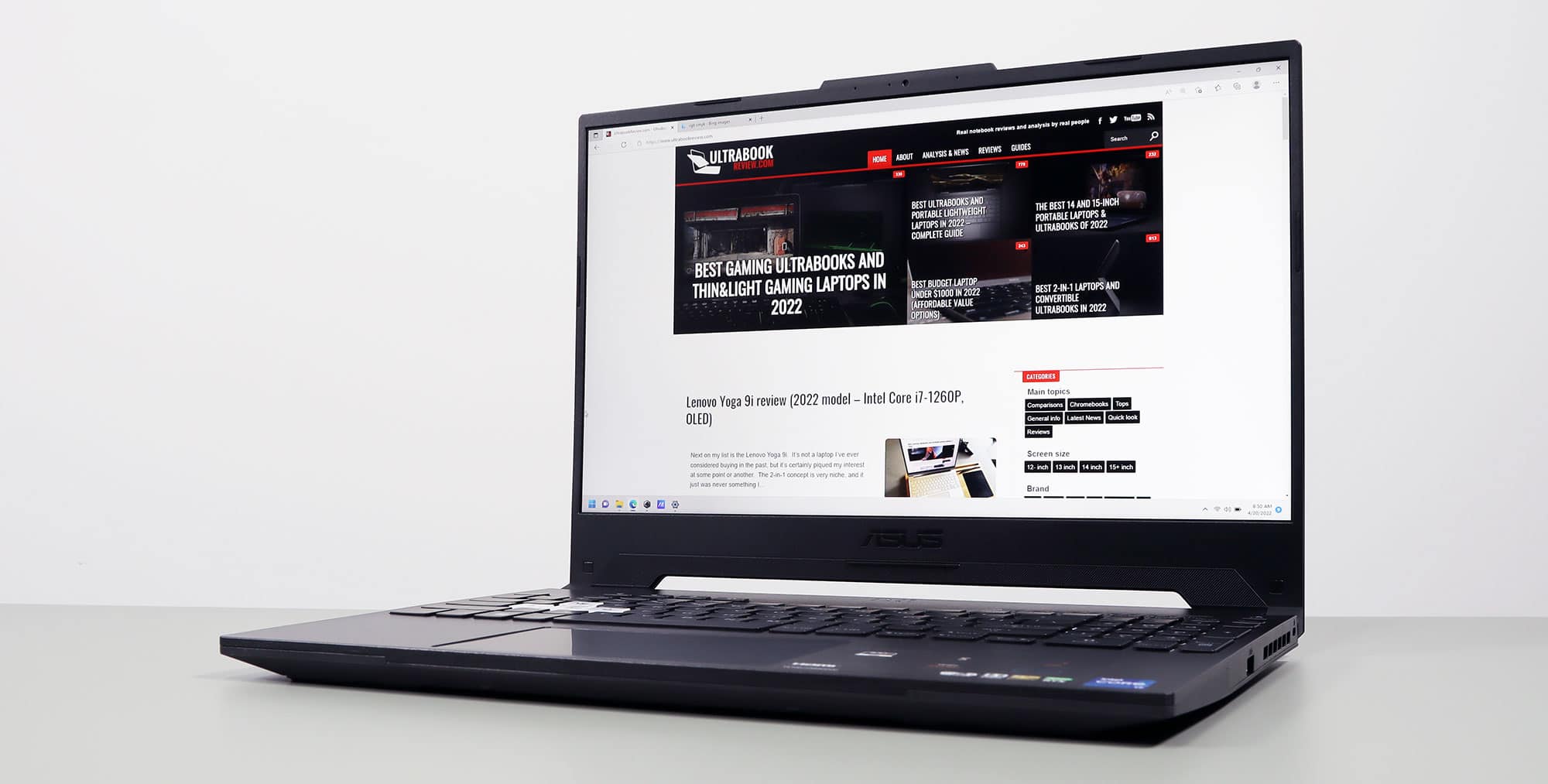
Disclaimer: Our content is reader-supported. If you buy through some of the links on our site, we may earn a commission.
Navigation: Ultrabookreview.com » 15.6 inch or larger
Our content is reader-supported. If you buy through some of the links on our site, we may earn a commission. Terms


Review by: Andrei Girbea
Andrei Girbea, Editor-in-Chief. I’ve a Bachelor’s in Computer Engineering and I’ve been covering mobile technology since the 2000s. You’ll mostly find reviews and thorough guides written by me here on the site, as well as some occasional first-impression articles.
. I’ve a Bachelor’s in Computer Engineering and I’ve been covering mobile technology since the 2000s. You’ll mostly find reviews and thorough guides written by me here on the site, as well as some occasional first-impression articles.






